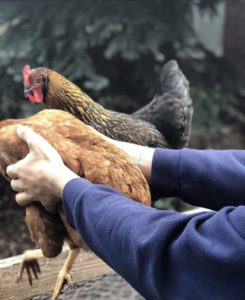Main Content

It isn’t uncommon to see a school or community garden in urban New Jersey, where residents come together to grow fresh food. Some people step it up a notch by introducing new members of the farm: chickens! As backyard chickens become more and more popular, some schools are considering the idea as well and are able to integrate Animal Science into their school day program. In 2016, we introduced chickens to our garden program at Essex County West Caldwell Tech.
Here’s how we implemented a poultry project at our school:
First we started off with the fundamentals, educating students about the beginning stages of life and basic biology of eggs and how they develop. We made this entire process fun, all while teaching science and raising adorable baby chicks. There are some essential materials needed:
- A mixed variety of fertilized chicken eggs
- A poultry incubator
- A manual on raising the chicks every step of the way and additional educational resources
- A brooding station to house the chicks
At Essex County West Caldwell Tech, students hatched 12 healthy chicks at the end of their 21-day incubation period.

Now that the chicks are out of the eggs, what’s next?
It is important to set up a brooder for your new feathered friends; it can be as simple as a cardboard box, plastic tub/container, or a commercial chick brooder. All will work splendidly as long as the chicks have their basic needs met, such as a source of heat, food, water, and proper bedding for easy maintenance.
Newly-hatched chickens will be very weak and fragile in their beginning hours and days (getting out of the egg is a very exhausting period of time for them). Sadly, some don’t even make it past hatching. As soon as the chickens hatch from their eggs, remove them from the incubator and move them to the brooder where they will dry their wet feathers and grow for the next six to eight weeks.
During the next six to eight weeks, you will get to know your chicks’ unique individual personalities. Like people, all chickens and most other animal species are very personable and can have some desirable and undesirable traits that come with them.
Once your chickens are fully feathered, they will be ready to go outdoors permanently in a larger housing unit called a coop. A coop is similar to a brooder in a sense that it contains your basic poultry needs minus heating (now that they are able to control their own body heat), but it will be much more spacious and have extra amenities.
Until they lay their first egg, your female chickens will be called pullets (female); males are cockerels. You can make a comfortable home for your teenage chickens by making it:
- Clean with watering bowls, feeders, bedding, places to roost and proper laying boxes,
- Safe for you and the birds,
- A fun place for you and the chickens.
For a start, make sure they are provided with adequate food and and clean water to drink. Raise them both from the ground to avoid pests and dirt in the containers. Next, add some roosts or sticks for the pullets to rest and sit on above ground. This also comes in handy for adding a sense of security for the birds if they need a place to escape to go if a predator breaks in the coop.
Essex County West Caldwell Tech learned this the hard way when half of their flock was killed by a fox. Security and safety is always important in a chicken coop, so be sure to take any and all precautionary measures to protect your birds based on potential local predators.
When the time comes, hens (females) will need a nest box to lay their eggs, a secure quiet area where hens can peacefully lay their eggs. On average, most breeds of chicken lay one egg a day. Different breeds yield different eggs and are bred for different purposes. You shouldn’t expect a lot or even any eggs from a bird bred for meat, compared to one that is bred for steady egg production.
4-H has many opportunities for schools and families alike to participate in animal science programs, for more information be sure to visit our poultry page on this Blog!
One last tip! Before starting an urban/school livestock program, be sure to check municipal law regarding each animal and contact your County 4-H Agent for Poultry Science resources to help you get started!
By Kenneth Nieves, Student, Essex County West Caldwell Tech, Animal Science Program and Marissa Staffen, Essex County 4-H Agent, Rutgers Cooperative Extension of Essex County